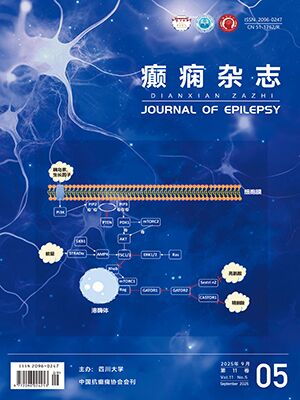| 1. |
Jing J, Herlopian A, Karakis I, et al. Interrater reliability of experts in identifying interictal epileptiform discharges in electroencephalograms. JAMA Neurol, 2020, 77(1): 49-57.
|
| 2. |
Fürbass F, Kural MA, Gritsch G, et al. An artificial intelligence-based EEG algorithm for detection of epileptiform EEG discharges: Validation against the diagnostic gold standard. Clin Neurophysiol, 2020, 131(6): 1174-1179.
|
| 3. |
Reus EEM, Visser GH, Cox FME. Using sampled visual EEG review in combination with automated detection software at the EMU. Seizure, 2020, 80: 96-99.
|
| 4. |
Golmohammadi M, Harati Nejad Torbati AH, Lopez de Diego S, et al. Automatic analysis of eegs using big data and hybrid deep learning architectures. Front Hum Neurosci, 2019, 13: 76.
|
| 5. |
Wilson SB, Harner RN, Duffy FH, et al. Spike detection. I. correlation and reliability of human experts. Electroencephalogr Clin Neurophysiol, 1996, 98(3): 186-198.
|
| 6. |
Wilson SB, Turner CA, Emerson RG, et al. Spike detection II: automatic, perception-based detection and clustering. Clin Neurophysiol, 1999, 110(3): 404-411.
|
| 7. |
Hughes JR. The significance of the interictal spike discharge: a review. J Clin Neurophysiol, 1989, 6(3): 207-226.
|
| 8. |
Asadollahi M, Noorbakhsh M, Salehifar V, et al. The significance of interictal spike frequency in temporal lobe epilepsy. Clin EEG Neurosci, 2020, 51(3): 180-184.
|
| 9. |
Krendl R, Lurger S, Baumgartner C. Absolute spike frequency predicts surgical outcome in TLE with unilateral hippocampal atrophy. Neurology, 2008, 71(6): 413-418.
|
| 10. |
Fisher RS, Acevedo C, Arzimanoglou A, et al. ILAE official report: a practical clinical definition of epilepsy. Epilepsia, 2014, 55(4): 475-482.
|
| 11. |
Proposal for revised classification of epilepsies and epileptic syndromes. Commission on Classification and Terminology of the International League Against Epilepsy. Epilepsia, 1989, 30(4): 389-399.
|
| 12. |
Engel JJr. A proposed diagnostic scheme for people with epileptic seizures and with epilepsy: report of the ILAE Task Force on Classification and Terminology. Epilepsia, 2001, 42(6): 796-803.
|
| 13. |
Fisher RS, Cross JH, French JA, et al. Operational classification of seizure types by the International League Against Epilepsy: Position Paper of the ILAE Commission for Classification and Terminology. Epilepsia, 2017, 58(4): 522-530.
|
| 14. |
Kane N, Acharya J, Benickzy S, et al. A revised glossary of terms most commonly used by clinical electroencephalographers and updated proposal for the report format of the EEG findings. Revision 2017. Clin Neurophysiol Pract, 2017, 2: 170-185.
|
| 15. |
Black MA, Jones RD, Carroll GJ, et al. Real-time detection of epileptiform activity in the EEG: a blinded clinical trial. Clin Electroencephalogr, 2000, 31(3): 122-130.
|
| 16. |
Scheuer ML, Bagic A, Wilson SB. Spike detection: Inter-reader agreement and a statistical Turing test on a large data set. Clin Neurophysiol, 2017, 128(1): 243-250.
|
| 17. |
Gotman J, Gloor P, Schaul N. Comparison of traditional reading of the EEG and automatic recognition of interictal epileptic activity. Electroencephalogr Clin Neurophysiol, 1978, 44(1): 48-60.
|
| 18. |
Stroink H, Schimsheimer RJ, de Weerd AW, et al. Interobserver reliability of visual interpretation of electroencephalograms in children with newly diagnosed seizures. Dev Med Child Neurol, 2006, 48(5): 374-377.
|
| 19. |
Webber WR, Litt B, Lesser RP, et al. Automatic EEG spike detection: what should the computer imitate? Electroencephalogr Clin Neurophysiol, 1993, 87(6): 364-373.
|
| 20. |
Bagheri E, Dauwels J, Dean BC, et al. Interictal epileptiform discharge characteristics underlying expert interrater agreement. Clin Neurophysiol, 2017, 128(10): 1994-2005.
|
| 21. |
Halford JJ, Arain A, Kalamangalam GP, et al. Characteristics of EEG interpreters associated with higher interrater agreement. J Clin Neurophysiol, 2017, 34(2): 168-173.
|
| 22. |
Halford JJ, Westover MB, LaRoche SM, et al. Interictal epileptiform discharge detection in eeg in different practice settings. J Clin Neurophysiol, 2018, 35(5): 375-380.
|
| 23. |
Halford JJ, Pressly WB, Benbadis SR, et al. Web-based collection of expert opinion on routine scalp EEG: software development and interrater reliability. J Clin Neurophysiol, 2011, 28(2): 178-184.
|
| 24. |
Halford JJ, Schalkoff RJ, Zhou J, et al. Standardized database development for EEG epileptiform transient detection: EEGnet scoring system and machine learning analysis. J Neurosci Methods, 2013, 212(2): 308-316.
|
| 25. |
Joshi CN, Chapman KE, Bear JJ, et al. Semiautomated spike detection software persyst 13 is noninferior to human readers when calculating the spike-wave index in electrical status epilepticus in sleep. J Clin Neurophysiol, 2018, 35(5): 370-374.
|
| 26. |
Reus EEM, Visser GH, Cox FME. Determining the spike-wave index using automated detection software. J Clin Neurophysiol, 2021, 38(3): 198-201.
|




